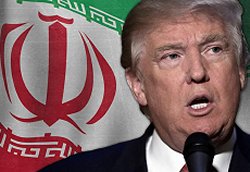
|
- Iran: Eight Prisoners Hanged on Drug Charges
- Daughter of late Iranian president jailed for ‘spreading lies’ - IRAN: Annual report on the death penalty 2016 - Taheri Facing the Death Penalty Again - Dedicated team seeking return of missing agent in Iran - Iran Arrests 2, Seizes Bibles During Catholic Crackdown
- Trump to welcome Netanyahu as Palestinians fear U.S. shift
- Details of Iran nuclear deal still secret as US-Tehran relations unravel - Will Trump's Next Iran Sanctions Target China's Banks? - Don’t ‘tear up’ the Iran deal. Let it fail on its own. - Iran Has Changed, But For The Worse - Iran nuclear deal ‘on life support,’ Priebus says
- Female Activist Criticizes Rouhani’s Failure to Protect Citizens
- Iran’s 1st female bodybuilder tells her story - Iranian lady becomes a Dollar Millionaire on Valentine’s Day - Two women arrested after being filmed riding motorbike in Iran - 43,000 Cases of Child Marriage in Iran - Woman Investigating Clinton Foundation Child Trafficking KILLED!
- Senior Senators, ex-US officials urge firm policy on Iran
- In backing Syria's Assad, Russia looks to outdo Iran - Six out of 10 People in France ‘Don’t Feel Safe Anywhere’ - The liberal narrative is in denial about Iran - Netanyahu urges Putin to block Iranian power corridor - Iran Poses ‘Greatest Long Term Threat’ To Mid-East Security |
Thursday 17 February 2011Demonstrations in Iran Bouncing back?
THE ECONOMIST, The tens of thousands of supporters of Iran's Green Movement who agitated for democracy in the centre of their capital, Tehran, on February 14th were supposed to have been brought to heel long ago. The leaders of the Islamic Republic have spent the past year celebrating the defeat of a "sedition" that represented, so they claimed, no more than a tiny minority of deluded and treasonous Iranians, egged on by their paymasters in the West. In the words of Ayatollah Ali Khamenei, the country's supreme leader, society had been "vaccinated" against these "germs." The protesters were answering an invitation from their two main leaders, Mir Hossein Mousavi and Mehdi Karroubi, to march in honour of the freedom-seekers of Egypt and Tunisia. Having put the pair under house arrest, the authorities were apparently caught out. The protesters, indistinguishable from ordinary commuters, were able to gather in large numbers and begin marching, mostly in silence, before the security forces responded. Their intervention lacked nothing in brutality. Police and members of the baseej militia, using truncheons and tear-gas, waded into groups of protesters. Later the authorities made the outlandish claim that the marchers had fired live bullets, killing two members of the security forces. Eyewitnesses said that the police did the firing and that the two victims were protesters. By nightfall, side-streets off the march route recalled the most dramatic scenes of agitation after the disputed presidential election of 2009, with protesters burning rubbish bins and taunting the security forces. Dozens of arrests were reported. Despite the bloodshed, the Green Movement has had a bounce. Mr Mousavi hailed a "big achievement" in the face of government violence and of those "pessimists" who had written the movement off. In contrast to his wariness in 2009, Barack Obama immediately called on Iran to let people express their opinions. Democracy-seekers in non-Arab Iran have been inspired by the success of their Arab neighbours. But they are chagrined by close comparisons. Despite protesting for longer and being the heirs to a century-old yearning for representative government, opposition campaigners have achieved less than their counterparts in Egypt and Tunisia, and paid a higher price. Scores of them lost their lives in the streets and detention centres in the aftermath of President Mahmoud Ahmadinejad's re-election in 2009. Thousands were arrested and tortured in the crackdown, and the political establishment represented by Messrs Khamenei and Ahmadinejad demonised the protesters as Western lackeys. In December 2009 a huge rally of the regime's supporters seemed to cast the movement into the shadows. Even now it is hard to say which group of Iranians will benefit from events in northern Africa. The country's leaders expect new Arab governments to adopt more of their viscerally anti-Western, anti-Israel policies, which the Green Movement regards with ambivalence. Moreover, pressure from the West, which may have helped speed change in Egypt and Tunisia, is a dead letter in Iran. Hardened by decades of confrontation and isolation, and riveted by ideology, the Islamic Republic is a tougher proposition than the discredited American clients of the Arab world. This still leaves Iran's destiny mainly in the hands of its internal disputants. Constrained by their own vulnerability, Messrs Karroubi and Mousavi have been unable to project a convincing programme, far less the wide-ranging constitutional changes their supporters seem to want. Indeed, the pair are more vulnerable than at any time since 2009, with hardliners in parliament baying for them to be executed for their role in what the speaker calls a "spurious and deviant movement aligned to American and Zionist goals." The latest events may turn out to be a new start for the Green Movement or a feeble echo of events far away. The funeral of one of the slain men, a student at Tehran University, was marked by clashes between protesters and loyalist students. The reserves of the Islamic Republic are deep, but the 71-year-old Mr Khamenei must be disquieted by the desire for democracy that is sweeping the region - and by a general disdain for geriatric autocrats. |






